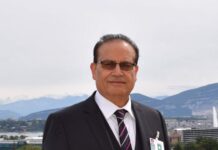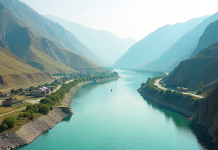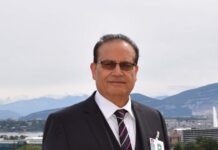Dr M Ali Hamza
In the realm of urban development, developed countries and cities often serve as laboratories, offering valuable lessons to others facing similar challenges. Izmir, Turkey’s third-largest city, stands as a prime example of successful urban transformation and sustainable development. Both Izmir and Pakistani cities face rapid urbanization, traffic congestion, and environmental challenges. They share a rich cultural heritage, with historical landmarks contributing to their identity and tourism potential. Additionally, both prioritize economic growth and seek to diversify their economies. Both regions also value community engagement, recognizing the importance of involving citizens in urban planning processes.
Despite differences in scale and context, these shared similarities provide opportunities for mutual learning and exchange of best practices, facilitating collaboration towards sustainable development and improved quality of life for residents. As Pakistan wrestles with rapid urbanization and the many issues accompanying it, there are valuable lessons it can learn from Izmir’s experience. From innovative infrastructure projects to community engagement initiatives, here’s what Pakistan can learn from Izmir.
One, Izmir’s journey towards sustainable urban planning began with a comprehensive vision that integrated economic growth, environmental preservation, and social equity. Pakistan and newly elected government can copy this approach by prioritizing long-term sustainability over short-term gains. Yes, shortsightedness has been an issue with all political parties in Pakistan. Countries with short-term planning typically focuses on immediate goals and challenges, such as addressing current economic fluctuations, responding to social crises, or managing political instability. In contrast, long-term planning involves strategic foresight to anticipate future trends and challenges, such as demographic shifts, technological advancements, and environmental sustainability. While short-term planning is reactive and often tactical, long-term planning requires vision, coordination, and investment in infrastructure, education, and innovation. In case of Pakistan long-term planning requires a sense of nationalism and inclusivity in political dialogue. All major political stakeholders have to keep the state interests before personalized benefits. How did countries like Turkey and Indonesia brought such level of inclusivity? That needs a separate article. But in any case, balancing short-term needs with long-term objectives is essential for ensuring the sustainable development and resilience of countries in an ever-changing global landscape. The political elite in Pakistan has to recognize this fact and must abandon short-termism, and then implementing zoning regulations, green spaces, and efficient public transportation systems can mitigate urban sprawl and environmental degradation.
Two, Izmir’s efficient public transportation network, including metro, tram, and ferry services, has revolutionized mobility within the city. As Pakistan’s ever-increasing population adding to traffic congestion and air pollution, it needs to invest in similar mass transit systems. Just to put on record, Mr Shahbaz Sharif, the then Chief Minister of Punjab and current Prime Minister of Pakistan launched mass transit system in Lahore; the capital of Punjab, with the technical help of Turkish experts, but that plan has been spoiled when opposition took charge of the government. Again, it is witnessed that government in power do not entertain the advice of opposition, so change in government brings in change in the already executed projects; Egos are prior to long lasting benefits for the citizens. Anyhow, addressing challenges like overcrowded and poorly maintained vehicles, inadequate infrastructure, unreliable schedules, safety concerns, and limited coverage and accessibility requires investment in modernizing transport systems, improving regulations, and promoting sustainable alternatives. Prioritizing and encouraging public transportation also reduces carbon emissions, which is the need of the hour.
Three, in general Turkey, but specifically Izmir is situated in a seismic zone and it has prioritized disaster preparedness and resilience in its urban planning strategies. Pakistan, prone to natural disasters such as earthquakes and floods, can adopt Izmir’s proactive approach by enforcing strict building codes, establishing early warning systems, and investing in disaster response infrastructure. Thank you to President Gen. Pervaiz Musharaf (late) who established the National Disaster Management Authority after the devastating earthquake of 2005 in Pakistan. NDMA is gradually improving its capability and can have program of mutual learning with AFAD.
Four, Izmir’s rich cultural heritage is preserved through the restoration of historic landmarks; ancient Agora, Kadifekale Castle, Clock Tower etc., and the promotion of cultural tourism. Pakistan can leverage its own cultural heritage to stimulate economic growth while preserving its identity. Revitalizing historic sites, promoting cultural events, and integrating heritage preservation into urban development plans can foster a sense of pride and belonging among citizens.
Five, Izmir has implemented various green initiatives, including urban parks, bicycle lanes, and waste management programs, to promote environmental sustainability. Pakistan can combat pollution and improve public health by investing in renewable energy, green spaces, and waste recycling facilities. Embracing eco-friendly practices not only enhances quality of life but also attracts investment and tourism.
Six, Izmir has embraced technology and innovation to enhance urban services and streamline administrative processes. Pakistan can harness the power of digitalization to improve governance, increase transparency, and deliver efficient public services. Implementing smart city solutions, such as digital infrastructure and e-governance platforms, can enhance the overall urban experience for residents.
Seven, Izmir’s success in urban development is attributed, in part, to active community engagement and participatory planning processes. Pakistan can foster inclusive decision-making by involving citizens, civil society organizations, and local stakeholders in the planning and implementation of development projects. Empowering communities to voice their concerns and contribute to shaping their urban environment promotes social cohesion and ownership. The element of community engagement on sustainable basis seems to be the weakest one in the context of Pakistan.
Eight, Izmir’s economy thrives on a diverse range of sectors, including manufacturing, trade, and tourism. Pakistan can foster economic diversification and entrepreneurship by investing in education, vocational training, and small-scale industries. Supporting local businesses and startups not only creates job opportunities but also reduces dependency on a single sector, ensuring long-term economic resilience. One of the dilemmas with our political governments is, that they focus more on resource allocation than resource generation. This temperament and approach need to be reversed.
As Pakistan confronts the challenges of rapid urbanization, it can draw inspiration from Izmir’s model of sustainable development. Pakistan can chart a path towards inclusive and resilient cities. The lessons learned from Izmir serve as a roadmap for Pakistan to build vibrant, liveable, and prosperous urban centres for future generations.

















